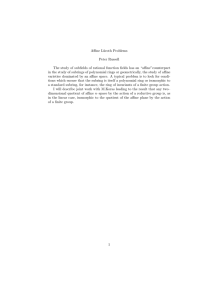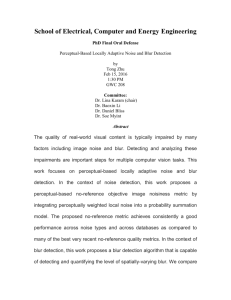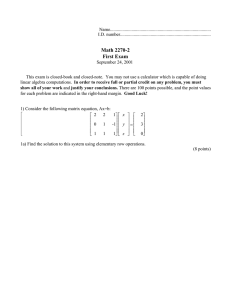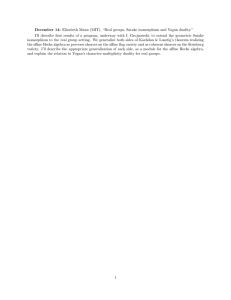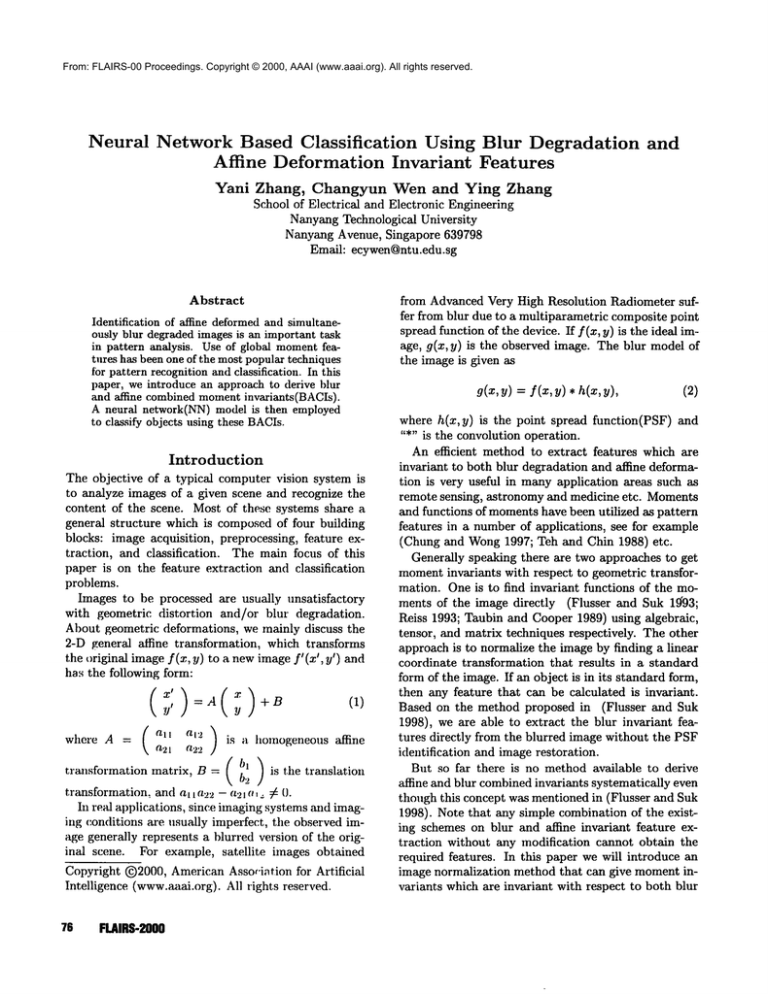
From: FLAIRS-00 Proceedings. Copyright © 2000, AAAI (www.aaai.org). All rights reserved.
Neural Network Based Classification
Using Blur Degradation
Affine Deformation Invariant Features
Yani
Zhang,
Changyun
Wen and Ying Zhang
School of Electrical and Electronic Engineering
Nanyang Technological University
Nanyang Avenue, Singapore 639798
Email: ecywen~ntu.edu.sg
Abstract
from Advanced Very High Resolution Radiometer suffer from blur due to a multiparametric composite point
spread function of the device. If f(x, y) is the ideal image, g(x, y) is the observed image. The blur model of
the image is given as
Identification of affine deformedand simultaneously blur degraded images is an important task
in pattern analysis. Use of global momentfeatures has been one of the most popular techniques
for pattern recognition and classification. In this
paper, we introduce an approach to derive blur
and affine combinedmomentinvariants(BACIs).
A neural network(NN) model is then employed
to classify objects using these BACIs.
(2)
Introduction
The objective of a typical computer vision system is
to analyze images of a given scene and recognize the
content of the scene. Most of these systems share a
general structure which is composed of four building
blocks: image acquisition, preprocessing, feature extraction, and classification.
The main focus of this
paper is on the feature extraction and classification
problems.
hnages to be processed are usually unsatisfactory
with geometric distortion and/or blur degradation.
About geometric deformations, we mainly discuss the
2-D general affine transformation, which transforms
the original image f(x, y) to a new image f’(x ~, y~) and
ha:~ the following form:
y’
=A
()
z
y
+B
(1)
whereA=( all a21 a22 al~) is a h°m°gene°us affine
transformation
matrix,
B = b.2 is the translation
(hi)
transformation.,and ali a._,2 - a21 st, _. ¢ 0.
In real applications, since imaging systems and imaging conditions are usually imperfect, the observed image generally represents a blurred version of the original scene. For example, satellite
images obtained
Copyright (~)2000, AmericanAsso-i,~tion for Artificial
Intelligence (www.aaai.org). All rights reserved.
76
FLAIRS-2000
and
where h(x, y) is the point spread function(PSF) and
"*" is the convolution operation.
An efficient method to extract features which are
invariant to both blur degradation and affine deformation is very useful in many application areas such as
remote sensing, astronomy and medicine etc. Moments
and functions of momentshave been utilized as pattern
features in a number of applications, see for example
(Chung and Wong1997; Teh and Chin 1988) etc.
Generally speaking there are two approaches to get
momentinvariants with respect to geometric transformation. One is to find invariant functions of the moments of the image directly (Flusser and Suk 19’93;
Reiss 1993; Taubin and Cooper 1989) using algebraic,
tensor, and matrix techniques respectively. The other
approach is to normalize the image by finding a linear
coordinate transformation that results in a standard
form of the image. If an object is in its standard form,
then any feature that can be calculated is invariant.
Based on the method proposed in (Flusser and Suk
1998), we are able to extract the blur invariant features directly from the blurred image without the PSF
identification and image restoration.
But so far there is no method available to derive
affine and blur combinedinvariants systematically even
though this concept was mentioned in (Flusser and Suk
1998). Note that any simple combination of the existing schemes on blur and affine invariant feature extraction without any modification cannot obtain the
required features. In this paper we will introduce an
image normalization method that can give momentinvariants which are invariant with respect to both blur
degradation and affine deformation. Firstly, we norrealize an image to a standard form. The key point of
this step is that the degree of blur should not have any
influence on such a standard form. To ensure this, we
impose normalization constraints by using blur invariant moments in contrast with existing methods. To
guarantee the existence of a solution, we then extend
the normalization transformation from real domain to
complex domain. The resulting moments of this step
are still affine invariants. Then we construct blur invariants based oll the obtained standard form and this
gives blur and affine combinedinvariants.
Neural networks can perform different tasks, one of
which is in the context of a supervised classifier (Tang,
Sriniivasan, and Ong 1996; Khotaanzad and Lu 1990).
As classifiers,
neural networks have the advantage of
allowing more complex decision boundaries in feature
space, and this results in lower error rates. In this
paper a neural network approach is used to do classification using BACIs.
The organization of this paper is as follows. In section 2, the feature extraction procedure is described.
Section 3 briefly introduces the structure of the neural network classifier and then gives the experimental
results. The conclusions are given in section 4.
Extraction
of BACIs
In this section, we mainly discuss the procedure of obtaining the blur and affine combined momentinvari¯ mts(BACIs). Firstly we introduce the basic knowledge
about moments. Then the xlormalization procedure to
get a standard form of an image is given. Lastly we
construct blur invariants based on the obtained stan(lard form and this gives BACIs.
Moments
Wenow give the definition of moments. The two dimensional (p + q)-th order geometric momentmpq of
gray-level image f(x, y) is defined by
mpq =
xVyq f(x, y)dxdy.
O0
(3)
O0
The. (p + q)-th order central nmnmnt#pq is defined
#,,q =
(x - x,.)P(y
oo
New Constraints
of Normalization
If an image is deformed by affine transformation and
degraded by blur simultaneously, we cannot obtain the
same standard position for both the original image and
the degraded image using the existing normalization
methods, such as those mentioned in (Voss and Suesse
1997).
We now propose a new scheme which uses blur invariant momentsas normalization constraints. By this
scheme, all the degraded images of the same object
with different blur degrees have the same standard position with respect to affine transformation. Weuse
four third order central moments#30, #12, #21, #03,
which are the simplest and lowest order blur invariants, as normalization constraints.
A nonsingular homogeneous affine transformation
matrix A can be separated into an x-shearing, a yshearing, and an anisotrope scaling matrix as follows:
(o1
a21
:(0
y
a22
c~ 0
’)(7
10
1
1)
fll)(y
(0
x).
An appropriate normalization procedure must be designed so that the four third order moments can be
used correctly to guarantee that the later normalization constraints will not destroy the previous ones. For
x-shearing normalization, we choose one which will
not be destroyed by the y-shearing normalization in
the steps followed. Amongthe four third order blur
invariants only #30=0 satisfy this requirements. For
y-shearing normalization, we choose #03=0. For the
anisotrope scaling normalization, #21 =#12 = 1 are used.
However, there may be no solution in the real domain
under these constraints. Thus we extend the normalization transformation, as presented in the remaining
part of this section, to the complex domain.
Extraction
of Blur and Affine Combined
Invariants
In this section, we will derive the blur and affine combined momentinvariants step by step. In the following,
#pq denote the central momentsof the original image.
X-Shearing
Normalization
Let #pq denote the
central moments after x-shearing normalization. Then
y, .)qf(x,y)dxdy, (4
oo
where x,. and y: are given by the relations
:r,, =
ID, 10
?D,0()
and
y,.=
’/D,O1
k=O
(5)
?D,00
and point (:r~., y:) is called the center of gravity or centroid of the image f(x, y).
Weuse the constraint that #~o = 0 to implement the
x-shearing normalization, i.e.,
I
#30 = P(~) =
where P(~) = P.30 + 3~#21 + 3B2#12 + f/3#03.
(8)
CLASSIFICATION 77
Y-Shearing Normalization
Let #pq
" be the central
momentsafter y-shearing normalization, then
I-gpq
l t p-}-q-l,l"
(9)
l=O
Similarly, we use itS3 -- 0 to const,’Mn the y-shearing
normalization, i.e.,
(10)
#0’3 = P(7) =
where P(7) = 372p~z + 37#~.~ + 143.
Anisotrope Scaling Normalization
Let iLpq’" be
the central momentsafter anisotrope scaling normalization, then,
m
p+l q-t-[,
it
ppq = t~ 6 t’pq.
ization.
I1!
~12=~21
Ill=1 to
scaling
Then from equation (11), we get
We now use
JZ’
process
the
(11)
normal-
That is, the group of (/3, 7) that results in the mini’" is chosen.
mumvalue of a given/Zpq
WhenP(/3) has a pair of conjugate complex roots
parameter/3 is chosen to be the real root of P(/3). 7
chosen as the root of P(7) that gives the same sign
Ill
the real part and imaginary part of a given #pq.
Blur and Affine Combined Invariants
Based on
the affine invariant moments obtained by normalization, blur and affine combined momentinvariants can
be constructed. If the PSF is central symmetry, only
the odd order blur invariants exist. The third, fifth
and seventh order blur and affine combined invariants
can be derived as follows. In the following equations
Az which are affine invariant, denote the moments
11‘pq
obtained at the standard position.
The third order BACIsare
Az =0, BACIo2=It¢./ =1,
BACIol =ILoz
BACIos = It., At = 1, BACIo4 =11‘.3o
AI =(}.
The fifth order BACIsare
=VZ
= 11,50
At
/ 00~’//2o,
3 , AI
AI
BACIz
(13)
Parameter Selection Criteria Note that P(/3) will
have three solutions and P(7) will have two solutions.
Thus we will have six groups of/3 and 7. This means
that we will have six standard positions for a given
object. Clearly some of them are unnecessary and need
to be deleted so that only one standard position is left.
This can be done by appropriately selecting parameters
fl ~md7. Wenow give the following two lemmas on how
to select parameters/3 and 7- The proofs can be found
in (Zhang 1999).
6
AI
BACI2 = P41
Finally, it is summarizedthat the resulting image satisfies the normalization constraint~
=o, = 1, = 1, =o.
At
BACIz
+2.f/),
3 ,.tOt~o=
AI + 21~a~),
Az
BACI4
//23 -- -frO0
BACIh=
AI
Itl4
6 , AI~
-- ..--TT
L//o’,),
UO0
BACIe = /tOn
AI
The seventh order BACIs are
A~- ,--,2Ttl
21 , i 50
Az
Al,),
BACIr = ~UTo
P2o
/~00
AI AI r...AI..AI
5ltfg
~ -- ,-’:’~-L
)3 "2 //so/~zz
BACIa
= #6A1
+ ’JH’41i’20 -~
/~oo
I, emrna 1 If P(~3) has three real roots, namely/3~,i
1, 2, 3, then for each/3i, P(7) will result in two real
roots.
JT, emrna 2 If P(/3) has a pair of conjugate complex
roots, P(7) has a pair of conjugat.c complex roots.
this case, only the real root of F(~) can satisfy the
normalization constraints (13).
WhenP(/3) has three real roots, we will have six
real groups of solutions from equation (8) and (10).
By considering/~pq’" in (11), a suitable group of/3 and
7 can be obtained as follows:
(14)
78
FLAIRS-2000
90 . AZ’~-
"4-
~(,11‘20
),
BACI9 = #A2t- s-’~-i,/’50
1 , AI AI
AI
~02 .,~
+ IU/J’32
P"O0
I
AI 20ttAl
//20
-t-
30 . AI2..
AI AI\
..
AI AI
+ lUp’41 J[’$11 "~ 5//’40/)+ ~(,~20 -I- zt[/,20 ]LII ),
# .J~l
3 ,.~ A1
A! AI . ~ Ai AI
BACIlo
=//4Az- ,-7/-X-i-~o//2.,~
+ 4pAl+ /~41
//o= ~ a//3’,//~
I*O0
.
az At,
~’//23//20
BACI~I =//A~
) -’t-
3 ,.~
--~ I,O//22
//O0
AI2 " " AI AI 2
AI AI,
~ [ /~11 4- z:It2o/ttl
"k-//02 It2o 1,
36 "2
AI 4~~Aat’-t-. tt14
al //20
At +4
-I-
2
36 z, A1 2 . . AI AI
.~_,Zlt32AIP, AI~
.
O2) + -’-----x
//A0/2 t/-/-611 "4- Z/I02 ]~11
At LAI
/.&23 I 11
AI AIx
"{’-//20/102 ),
BACI~2
Al
1 , AI AI .,,t- a~ AI 20g;~J
1120-3 1.tl/t23 /tO.2 "4/too
30 ,. AI2 A AI Alx
AI
AI)
= 11.25 -- ..--.-.-.-.-.-~7(1105
.,,
AI
+ 1U1/’14 1/’11
"4-
511,
"4-
~P’20
Poo-
Jr"
411"02
]tll
Hiddern
/er
Input
Layer
),
3 ,,. A1 AI r, AI AI r. AI
BACI13 =ItlaA1-- /-~-a/tZ/’o5
lLtl + o1,14Ito2 +alto., )
2.
90 , AI
Output
Layer
fl
Class I
1"
2
Class 2
/to~
d.,t/to,),
21 , AI AIx
BACI14
= ItA( -- .--AykItos
tto2 1.
Itoo
Class M
fN
Note that BACI01 to BACI04 are normalization
constraints which are the same for all nornlalized images. Thus we use the fourteen features BACII to
BACII4 during classification process.
Classification
Figure 2: The structure
of MLP
Using NN
Based on the BACIsobtained in the last section, image
classification
can be performed using neural network
classifiers. A block diagram of our blur and affine invariant classification system is presented in Figure 1.
Feature Extraction
4
hldependent
~ of
I-~1
Network
I-~1
Re.~;ults
Novmali~,’io,t
I SACt
I. I C’"~incrl
L
6
5
]
J
7
8
9
10
Figure 1: The system architecture
Figure 3: Set of fish inmges used as reference
Feedforward neural networks have been frequently
used for pattern recognition and classification.
Multilayer perceptrons (MLPs) networks trained with the
back propagation algorithm are typical representative
of this class of networks. MLPsconsist of multiple layers of neurons: an "inlmt layer", one or more "hidden
layers", and an "OUtl)ut layer". The structure of the
MLPwith one hidden layer is shown in Figure 2. The
network attempts to implement a mal)l)ing between
input feature set and a desired om.t,ut pattern.
In our experiment, an MLPwii, h one hidden layer
is used. The immber of neurons in the input layer is
the same as the number of features. In our case, the
fourteen blur and affine combined momentinvariants
are used as inputs to the neural network. The number of hidden neurons is determined heuristically I)ase(l
on the trade-off between complexity and classification
ability of the net. The Immberof neurons in the output layer is equal to the nulnber of classes which is ten
in our studies. The activation flmction for the neurons
of the hidden layer and the output layer used is the
sigmoid function.
Figure 4: Sampleimages of fish ’3 fl’om the database.
Ore" test objects consists of gray-level inmgesof fish
that are l)resented directly to the system. The reference objects are. shownin Figure 3. ()ne tnmdred (lifferent affine defornted, blur degrade(i, and affiim and
I)hu’ combined images are generated for each reference
object. Examples of these images tbr fish 3 are shown
CLASSIFICATION 79
in Figure 4. The first row is fish 3 detbrmed by different affine trausformations.
Tile secoud row is the
corre.spondiug blur and a/fine combined versions.
There are total 1000 images in the database for tim
l I) ,’eferenee objects. The available samples are divided into two sets for training
and testing.
We use
40 training images and 60 testing images per reference
object. For each inaage, the fourteen BACIs, BACII
to BACI14, eu’e calculated and fed to the neural network to perform the classification
process. The values
of BACIs of fish 3 and the four images in the second
row of Figure 4 are listed in Tabh, I.
Fish 3
BACII
BACI2
BACI3
BACI4
BACI.~
BACI(~
BACI7
BACIs
BACI9
BACIto
BACI, I
BACI,.2
BACIx3
BACII4
BDADI2
0 + 0.5273i
-0.4348 + 0.1590i
-0.5121 + 0.2636i
-0.3024 + 0.1809i
-0.4072 + 0.2024i
-0.5121 + 0.2278i
-0.1274 + 0.4137i
0- 1.5650i
0.8502 - 0.7825i
-0.2307 + 0.2207i
0.4078 + 0.0334i
0.8502 - 0.4735i
0.5617 - 0.1472i
0.7087 - 0.3191i
original image
0 + 0.5222i
-0.4332 + 0.1610i
-0.5104 + 0.2611i
-0.2999 + 0.1816i
-0.4051 + 0.2019i
-0.5104 + 0.2216i
-0.1262 + 0.4173i
0- 1.5507i
0.8441 - 0.7754i
0.2321 + 0.2211i
0.4077 + 0.0320i
0.8441 - 0.4720i
0.5652 - 0.1491i
0.7047 - 0.3203i
BDADI3
0 + 0.4953i
-0.4195 + 0.1599i
-0.5077 + 0.2477i
-0.2851 + 0.17(18i
-0.3964 + 0.1850i
-0.5077 + 0.2059i
-0.1247 + 0.3922i
0- 1.4336i
0.8182 - 0.7168i
0.2126 + 0.1963i
0.3695 + 0.0234i
0.8182 - 0.4289i
0.5220 - 0.1327i
0.6702 - 0.2850i
BDADI1
0 + 0.5217i
-0.4333 + 0.1577i
-0.5111 + 0.2608i
-0.3008 + 0.1787i
-0.4056 + 0.1996i
-0.5111 + 0.2199i
-0.1310 + 0.4168i
0- 1.5450i
0.8442 - 0.7725i
0.2282 + 0.2286i
0.4045 + 0.0356i
0.8442 - 0.4674i
0.5629 - 0.1442i
0.7036 - 0.3149i
BDADI4
0 + 0.5542i
-0.4439 + 0.1896i
-0.5041 + 0.2771i
-0.3093 + 0.2134i
-0.4067 + 0.2348i
-0.5041 + 0.2489i
0.0871 + 0.4513i
0- 1.715i
0.8550 - 0.8573i
0.2816 - 0.2302i
0.4644 + 0.0092i
0.8550 - 0.5516i
0.6157 - 0.2050i
0.7353 - 0.3987i
Tablr. 1: Tile values of BACIsof fish 3 mid its blur degraded and affine deformed images(BDADI) as shown
in t, he second row of Figure 4
The main problem in using an MLP is how to choose
optim~ parameters for tile network. There is currently
no stan(tard technique for automatically setting the I)arameters of an MLP.Tal)le 2 shows the best results obtained after mnnerous experiInent’,
The l)ercentage of
correct classifications
in the test :a:t is about 99% and
clearly this is very high. Most of the errors are due to
the quantization caused by ~tffine transformation.
Future work could be done in the, feature extraction stage
to improve the i)erformanee of the system.
80
FLAIRS-2000
No. Of
Hiddern
Neurons
6O
ing
Momentum Rate
Error
Level
Iteration
Rate
0.05
Initial
Weights
Range
0.1
0.001
1,000
[-0.5,0.5]
Learn-
Table 2: Neural
Network Parameters
Conclusion
The main objective of this paper is to develop a neural
network based blur degradation
and affine deformation combined invariant classification
system. In the
feature extraction
stage, we propose a normalization
method to determine blur and a~ine combined invariants. By applying the proposed method, a set of blur
and affine combined invariants
can be obtained. Then
the classification
is done using a multilayer perceptron
network (MLP) with back-propagation
learning.
The
system has been tested and has shown a high classification accuracy.
References
Chung, Y. Y., and Wong, M. T. 1997. Neural network based image recognition
system using geometric
moment. IEEE TENCON 383-386.
Flusser,
J., and Suk, T. 1993. Pattern
recognition by affine moment invariants.
Pattern Recognition
26:167-174.
Flusser, J., and Suk, T. 1998. Degraded image analysis: an invariant
approach. IEEE Trans. Pattern
Analysis and Machine Intelligence
20:590-603.
Khotaanzad, A., and Lu, J. 1990. Classification
of invariant image representations
using a neural network.
IEEE Trans. Acoustics Speech and Signal Processing
38:1028-1038.
Reiss, T. H. 1993. Recognizing Planar Objects
Invariant Image Features. Springer, Verlag.
Using
Tang, H. W.; Sriniivasan,
V.; and Ong, S. H. 1996.
Invariant object recognition using a neural template
classifier,
hnage and Vision Computing 14:473-483.
Taubin, G., and Cooper, D. 1989. Object recognition
based on moment(or algebraic)
invariants.
Geometric
invariance in computer vision 10:243-250.
Teh, C. H., and Chin, R. T, 1988. On image analysis
by the method of moments. IEEE Trans.
Pattern
Analysis and Machine Intelligence
10:496-513.
Voss, K., and Suesse, H. 1997. Invariant fitting
of
l)lanar
objects by primitives.
IEEE Trans. Pattern
Analysis and Machine Intelligence
19:80-84.
Zhang, Y. 1999. Image analysis using moments. Technical report, Technical Report, Nanyang Technological University.



